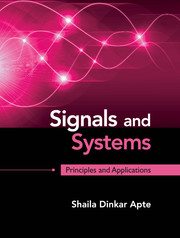Book contents
- Frontmatter
- Dedication
- Contents
- Preface
- 1 Introduction to Signals
- 2 Signals and Operations on Signals
- 3 CT and DT Systems
- 4 Time Domain Response of CT and DT LTI Systems
- 5 Fourier Series Representation of Periodic Signals
- 6 Fourier Transform Representation of Aperiodic Signals
- 7 Laplace Transform
- 8 Z Transform
- 9 Random Signals and Processes
- Index
6 - Fourier Transform Representation of Aperiodic Signals
Published online by Cambridge University Press: 05 May 2016
- Frontmatter
- Dedication
- Contents
- Preface
- 1 Introduction to Signals
- 2 Signals and Operations on Signals
- 3 CT and DT Systems
- 4 Time Domain Response of CT and DT LTI Systems
- 5 Fourier Series Representation of Periodic Signals
- 6 Fourier Transform Representation of Aperiodic Signals
- 7 Laplace Transform
- 8 Z Transform
- 9 Random Signals and Processes
- Index
Summary
The chapter deals with Fourier transform (FT) representation for continuous time and discrete time aperiodic signals. The FT of CT signals is called as CTFT and that for DT signals is called as DTFT. The Fourier transform is defined and is evaluated for all standard aperiodic signals such as exponential signal, rectangular pulse, triangular pulse, etc. The IFT of some standard signals such as sinc function is also discussed. The use of Dirac Delta function is explained for evaluation of FT for periodic signals. FT of DT signals are illustrated with some numerical examples. Properties of FT and DTFT are emphasized with their physical significance. The numerical examples for the calculation of FT using FT properties are illustrated. The calculation of response of LTI system to the input signal is simplified using FT.
Fourier Transform Representation of Aperiodic CT Signals
If the signal x(t) is aperiodic, a similar representation for a signal in frequency domain can be developed in terms of Fourier Transform using exponential signals as basis function. The signal xP(t) a periodic signal can be generated by repeating x(t) after a period of T0. We can now define x(t) as
The Fourier series representation can be written for the periodic signal xP(t). Equation (5.38) becomes
The coefficients can be written as
As the period tends to infinity, the spacing between the spectral lines, which is equal to 1/T0, will tend to zero and the spectrum will be a continuous spectrum. Now, the summation will turn into the integral. The coefficients will represent a frequency point on the frequency axis represented by X(f).
- Type
- Chapter
- Information
- Signals and SystemsPrinciples and Applications, pp. 409 - 512Publisher: Cambridge University PressPrint publication year: 2016



